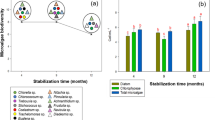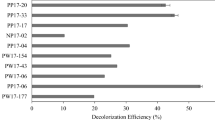Abstract
This two-week anaerobic batch study evaluated 2,4,6-trinitrotoluene (TNT) removal efficiency from industrial pink water by (1) adsorption on low-cost adsorbent pine bark, and (2) adsorption coupled with TNT biotransformation by specialised microbial communities. Samples of the supernatant and acetonitrile extracts of pine bark were analysed by HPLC, while the composition of the bacterial community of the experimental batches, inocula and pine bark were profiled by high-throughput sequencing the V6 region of the bacterial 16S rRNA gene. Integrated adsorption and biotransformation proved to be the most efficient method for TNT removal from pink water. The type of applied inoculum had a profound effect on TNT removal efficiencies and microbial community structures, which were dominated by phylotypes belonging to the Enterobacteriaceae family. The analysis of acetonitrile extracts of pine bark supported the hypothesis that the microbial community indigenous to pine bark has the ability to degrade TNT.






Similar content being viewed by others
References
Argun ME, Dursun S, Karatas M (2009) Removal of Cd(II), Cu(II), and Ni(II) from water using modified pine bark. Desalination 249:519–527
Blazquez G, Martin-Lara MA, Dionisio-Ruiz E, Tenorio G, Calero M (2011) Evaluation and comparison of the biosorption process of copper ions onto olive stone and pine bark. J Ind Eng Chem 17:824–833
Cervantes FJ (2009) Environmental technologies to remove recalcitrant N-pollutants from wastewaters. In: Cervantes FJ (ed) Environmental technologies to treat nitrogen pollution principles and engineering. IWA Publishing, London, pp 140–199
Chong HL, Chia PS, Ahmad MN (2013) The adsorption of heavy metal by Bornean oil palm shell and its potential application as constructed wetland media. Bioresour Technol 130:181–186
Chusova O, Nõlvak H, Truu J, Truu M, Oopkaup K, Nehrenheim E, Odlare M (2014) Effect of pine bark on the biotransformation of trinitrotoluene and on bacterial community structure in a batch experiment. Environ Technol 35(17–20):2456–2465
Daun G, Lenke H, Reuss M, Knackmuss H-J (1998) Biological treatment of TNT-contaminated soil. 1. Anaerobic cometabolic reduction and interaction of TNT and metabolites with soil components. Environ Sci Technol 32:1956–1963
Dizhbite T, Zakis G, Kizima A, Lazareva E, Rossinskaya G, Jurkjane V, Telysheva G, Viesturs U (1999) Lignin—a useful bioresource for the production of sorption-active materials. Bioresour Technol 67:221–228
Eaton HL, Duringer JM, Murty LD, Craig AM (2013) Anaerobic bioremediation of RDX by ovine whole rumen fluid and pure culture isolates. Appl Microbiol Biotechnol 97:3699–3710
E.C. (2000) Commission Decision on the European List of Waste (COM 2000/532/EC), European Commission http://eurlex.europa.eu/LexUriServ/LexUriServ.do?uri=CONSLEG:2000D0532:20020101:EN:PDF; 2013-10-07
Ederer MM, Lewis TA, Crawford RL (1997) 2,4,6-Trinitrotoluene (TNT) transformation by Clostridia isolated from a munition-fed bioreactor: comparison with non-adapted bacteria. J Ind Microbiol Biotechnol 18:82–88
Frank DN (2009) BARCRAWL and BARTAB: software tools for the design and implementation of barcoded primers for highly multiplexed DNA sequencing. BMC Bioinform 10:362
Hao X, Jiang R, Chen T (2011) Clustering 16S rRNA for OTU prediction: a method of unsupervised Bayesian clustering. Bioinformatics 27:611–618
Hartmann M, Howes CG, Abarenkov K, Mohn WW, Nilsson RH (2010) V-Xtractor: an open-source, high-throughput software tool to identify and extract hypervariable regions of small subunit (16S/18S) ribosomal RNA gene sequences. J Microbiol Methods 83:250–253
Ho YS, McKay G (2000) The kinetics of sorption of divalent metal ions onto sphagnum moss peat. Water Res 34:735–742
Ho YS, Ofomaja AE (2006) Kinetic studies of copper ion adsorption on palm kernel fibre. J Haz Mat 137:1796–1802
Hummelen R, Fernandes AD, Macklaim JM, Dickson RJ, Changalucha J, Gloor GB, Reid G (2010) Deep sequencing of the vaginal microbiota of women with HIV. PLoS One 5:e12078
Jang A, Seo Y, Bishop PL (2005) The removal of heavy metals in urban runoff by sorption on mulch. Environ Poll 133:117–127
Kim J, Yu YK, Yan F, Bang J, You T, Lee SS (2012) A new strain of bacteria degrading TNT and 2,4/2,6-DNT from explosives-contaminated soil. Atlas J Biol 2:116–124
Kulkarni M, Chaudhari A (2007) Microbial remediation of nitro-aromatic compounds: an overview. J Environ Manag 85:496–512
Li Y, Chen B, Zhu L (2010) Enhanced sorption of polycyclic aromatic hydrocarbons from aqueous solution by modified pine bark. Bioresour Technol 101:7307–7313
Li AZ, Marx KA, Walker J, Kaplan DL (1997) Trinitrotoluene and metabolites binding to humic acid. Environ Sci Technol 31:584–589
Maloney SW, Adrian NR, Hickey RF, Heine RL (2002) Anaerobic treatment of pinkwater in a fluidized bed reactor containing GAC. J Hazard Mater 92:77–88
McArdle BH, Anderson MJ (2001) Fitting multivariate models to community data: a comment on distance-based redundancy analysis. Ecology 82:290–297
McDonald D, Price MN, Goodrich J, Nawrocki EP, DeSantis TZ, Probst A, Andersen GL, Knight R, Hugenholtz P (2012) An improved Greengenes taxonomy with explicit ranks for ecological and evolutionary analyses of bacteria and archaea. ISME J 6:610–618
Millerick K, Drew SR, Finneran KT (2013) Electron shuttle-mediated biotransformation of hexahydro-1,3,5-trinitro-1,3,5-triazine adsorbed to granular activated carbon. Environ Sci Technol 47:8743–8750
Nehrenheim E, Gustavsson J-P (2008) Kinetic sorption modelling of Cu, Ni, Zn, Pb and Cr ions to pine bark and blast furnace slag by using batch experiments. Bioresour Technol 99:1571–1577
Nehrenheim E, Odlare M (2010) Treatment of explosives contaminated water by using pine bark in a batch process—potentials and kinetics. In: Proceedings crete 2010, second international conference of hazardous and industrial waste management, Chania, Greece
Nehrenheim E, Odlare M, Allard B (2011) Retention of 2,4,6-trinitrotoluene and heavy metals from industrial waste water by using the low cost adsorbent pine bark in a batch experiment. Water Sci Technol 64:2052–2058
Niedźwiecka JB, Finneran KT (2015) Combined biological and abiotic reactions with iron and Fe(III)-reducing microorganisms for remediation of explosives and insensitive munitions (IM). Environ Sci: Water Res Technol 1:34–39
Parameswaran P, Jalili R, Tao L, Shokralla S, Gharizadeh B, Ronaghi M, Fire AZ (2007) A pyrosequencing-tailored nucleotide barcode design unveils opportunities for large-scale sample multiplexing. Nucleic Acids Res 35:e130
Pruesse E, Quast C, Knittel K, Fuchs BM, Ludwig W, Peplies J, Glöckner FO (2007) SILVA: a comprehensive online resource for quality checked and aligned ribosomal RNA sequence data compatible with ARB. Nucleic Acids Res 35:7188–9196
Rodrigue S, Materna AC, Timberlake SC, Blackburn MC, Malmstrom RR, Alm EJ, Chisholm SW (2010) Unlocking short read sequencing for metagenomics. PLoS One 5:e11840
Schloss PD, Westcott SL, Ryabin T, Hall JR, Hartmann M, Hollister EB, Lesniewski RA, Oakley BB, Parks DH, Robinson CJ, Sahl JW, Stres B, Thallinger GG, Van Horn DJ, Weber CF (2009) Introducing mothur: open-source, platform-independent, community-supported software for describing and comparing microbial communities. Appl Environ Microbiol 75:7537–7541
U.S. EPA (1993) Handbook: approaches for the remediation of Federal Facility Sites Contaminated With Explosive Or Radioactive Wastes. EPA/625/R-93/013, U.S. Environmental Protection Agency, Office of Research and Development, Cincinnati, OH
U.S. EPA (2008) Hazardous wastes listing. U.S. Environmental Protection Agency, Code of Federal Regulations http://www.epa.gov/osw/hazard/wastetypes/pdfs/listing-ref.pdf; 2013-10-07
Werner JJ, Zhou D, Caporaso JG, Knight R, Angenent LT (2012) Comparison of Illumina paired-end and single-direction sequencing for microbial 16S rRNA gene amplicon surveys. ISME J 6:1273–1276
Zhang JP, Lin XY, Luo XG, Zhang C, Zhu H (2011) A modified lignin adsorbent for the removal of 2,4,6-trinitrotoluene. Chem Eng J 168:1055–1063
Zhao JS, Halasz A, Paquet L, Beaulieu C, Hawari J (2002) Biodegradation of hexahydro-1,3,5-trinitro-1,3,5, triazine and its mononitroso derivate hexahydro-1-nitroso-3,5-dinitro-1,3,5-triazine by Klebsiella pneumoniae strain SCZ-1 isolated from an anaerobic sludge. Appl Environ Microbiol 68:5336–5341
Acknowledgments
The authors would like to thank Zugol AB (Falun, Sweden) for supplying the pine bark and Mara Grube for useful discussions. In addition, we would like to acknowledge the project financing partners: Knowledge Foundation, Nammo Vingåkersverken AB, KCEM AB, Bofors Test Center AB, Cesium AB and Eriksson Patent AB. Participation of J. Truu, M. Truu, H. Nõlvak, and K. Oopkaup in study was supported by the Ministry of Education and Research of the Republic of Estonia (Grant IUT2-16), and by the European Regional Development Fund through ENVIRON (Centre of Excellence in Environmental Adaptation).
Author information
Authors and Affiliations
Corresponding author
Electronic supplementary material
Below is the link to the electronic supplementary material.
Rights and permissions
About this article
Cite this article
Chusova, O., Nõlvak, H., Odlare, M. et al. Biotransformation of pink water TNT on the surface of a low-cost adsorbent pine bark. Biodegradation 26, 375–386 (2015). https://doi.org/10.1007/s10532-015-9740-7
Received:
Accepted:
Published:
Issue Date:
DOI: https://doi.org/10.1007/s10532-015-9740-7




